The story of the Babbacombe murder, the three attempts to hang the alleged accused, the innocence debate and a great many other issues filled the media for years to come. Indeed these ‘Fallout’ pages reveal some quite outstanding revelations of those directly involved in the murder case and those who were not.
Here we discover what became of a few and one or two outrageouis rumours that circulated around newsrooms and society in general.

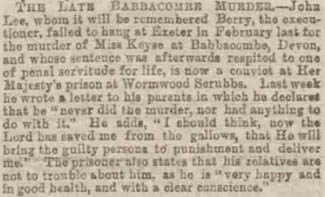
“The Late Babbacombe Murder. – John Lee, whom it will be remembered Berry, the executioner, failed to hang at Exeter in February last for the murder of Miss Keyse at Babbacombe, Devon, and whose sentence was afterwards respited to one of penal servitude at Her Majesty’s prison at Wormwood Scrubs.

Last week he wrote a letter to his parents in which he declared that he “never did the murder, nor had anything to do with it.” He adds, “I should think, now the Lord has saved me from the gallows, the He will bring the guilty persons to punishment and deliver me.” The prisoner also states that his relatives are not to trouble about him, as he is “very happy and in good health, and with a clear conscience.”
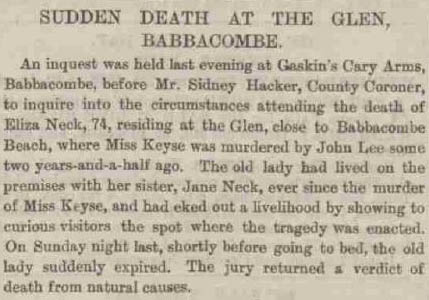
Three days later the local and national media were reporting her ‘sudden death’ with headlines that no-doubt renewed memories of the horrific demise of her mistress just over a year earlier:
“An inquest was held last evening at Gaskin’s Cary Arms, Babbacombe, before Mr Sidney Hacker, County coroner, to enquire into the circumstances attending the death of Eliza Neck, 74, residing at the Glen, close to Barbbacombe Beach, where Miss Keyse was murdered by John Lee some two and a half years ago. The old lady had lived on the premises with her sister, Jane Neck, ever since the murder of Miss Keyse, and had eked out a livelihood by showing curious visitors the spot where the tragedy was enacted. On Sunday night last, shortly before going to bed, the old lady suddenly expired. The jury returned a verdict of death from natural causes.”
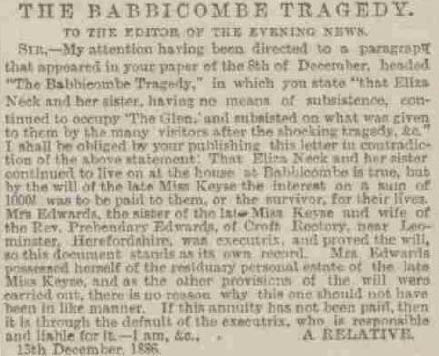
However, Elza’s death (or should I say, the reporting of her death) caused indignation in certain quarters. Editorial of her demise and the suggestion that the sisters “had eked out a livelihood by showing curious visitors the spot where the tragedy was enacted” sparked an instant reaction in Edinburgh by a relative (almost certainly Emma Keyse brother, George Whitehead, who was a resident of the Scottish capital). He wrote to the Edinburgh Evening News – Tuesday 14 December 1886 after a similar report was spotted in Scottish media:
“My attention having been directed to a paragraph that appeared in your paper on the eighth of December, headed “The Babbicombe Tradegy”, in which you state “that Eliza Neck and her sister, having no means of subsistence, continued to occupy “The Glen,” and existed on what was given to them by the many visitors after the shocking tragedy …” I shall be obliged by your publishing this letter in contradiction of the above statement: that Eliza Neck and her sister continued to live on in the house at Babbicombe is true, but by the will of the late Miss Keyse the interest on eightsome of £1000 was to be paid to them, or the survivor, for their lives.
Mrs Edwards, the sister of the late Miss Keyse and wife of the Rev Prebendary Edwards, of Croft Rectory, near Leominster, Herefordshire, was excutrix, and prove to the will, so this document stands as its own record. Mrs Edwards possessed herself of the residuary personal estate of the late Miss Keyse, and adds the other provision of the will were carried out, there is no reason why this one should not have been in like manner. If this annuity has not been paid, then it is through the default of the executrix, who is responsible and liable for it. — I am, &c., A. RELATIVE 13 December, 1886.
Apart from the murder, the investigation and the botched hanging, probably the most sensational news as far as this story is concerned in the 1880s was the extensive explosive coverage of an alleged “deathbed confession” by an immediate member of Emma Keyse household and relation of John Lee.
There are a great many news articles that create serious doubt on the evidence of and accusations against the accused. For those in doubt Lee’s guilt this must have been open season.
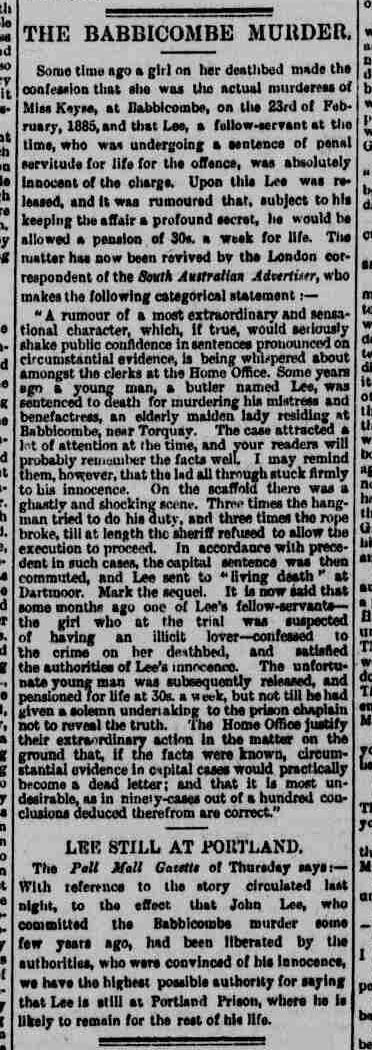
Whilst it is quite possible that Elizabeth Harris (Lee’s half-sister) could have been the individual who allegedly “confessed” a large amount of sensationalism surrounds the editorial of some of these stories; for example the fact that John Lee had already been released from prison and on a pension of 30 shillings a week, or the fact that he had been released and was given a new name and identity. All this of course was totally untrue and the British Home Office, indeed the Home Secretary, was very keen to reinforce the facts which were that Lee was still in prison and serving his sentence:
“Some time ago a girl on her deathbed made the confession that she was the actual murderess of Miss Keyse, at Babbicombe, on the 23rd of February, 1885, and that Lee, a fellow servant at the time who was undergoing a sentence of penal servitude for life for the offence, was absolutely innocent of the charges. Upon this Lee was released, and it is rumoured that, subject to his keeping the affair a profound secret, he would be allowed a pension of 30 shillings a week for life. The matter has now been revived by the London correspondent of the South Australian Advertiser, who makes the following categorical statement;
“A rumour of a most extraordinary and sensational character, which, if true, would seriously shake public confidence in sentences pronounced on circumstantial evidence, is being whispered about amongst the clerks at the Home Office.
Some years ago a young man, a butler named Lee, was sentenced to death for murdering his mistress and benefactress, an elderly maiden lady residing at Babbicombe, near Torquay. The case attracted a lot of attention at the time, and your readers will properly remember the facts well. I may remind them, however, that the lad all through stuck firmly to his innocence. On the scaffold there was a ghastly and shocking scene. Three times that Hangman tried to do his duty, and three times the rope broke, till at length the sheriff refused to allow the execution to proceed. In accordance with precedent in such cases the capital sentence was then commuted, and Lee sent to “living death” at Dartmoor. Mark the sequel. It is now said that some months ago one of Lee’s fellow servants — the girl who at the trial was suspected of having an illicit lover — confessed to the crime on her deathbed, and satisfy the authorities of Lee’s innocence. The unfortunate young man was subsequently released, and pension for life at 30 shillings a week, but not till he had given a solemn undertaking to the prison chaplain not to reveal the truth.
The Home Office justify their extraordinary action in the matter on the ground that, if the facts were known, circumstantial evidence in capital cases would practically become a dead letter: and that it is most undesirable, as in 90 cases out of a hundred conclusions deduced therefrom are correct.”
LEE STILL AT PORTLAND
The Pall Mall Gazette of Thursday says: –
With reference to the story circulated last night, to the effect that John Lee, who committed the Babbicombe murder some years ago, had been liberated by the authorities, who were convinced of his innocence, we have the highest possible authority for saying that Lee is still at Portland prison, where he is likely to remain for the rest of his life.”
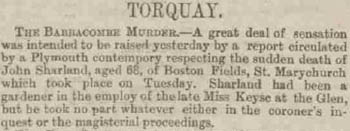
“The Babbacombe Murder – A great deal of sensation was intended to be raised yesterday by a report circulated by a Plymouth contemporary respecting the death of John Sharland, aged 68, of Boston Fields, St. Marychurch, which took place on Tuesday. Sharland had been a gardener in the emply of the late Miss Keyse at the Glen, but he took no part in the coroner’s inquest or the magisterial proceedings.”
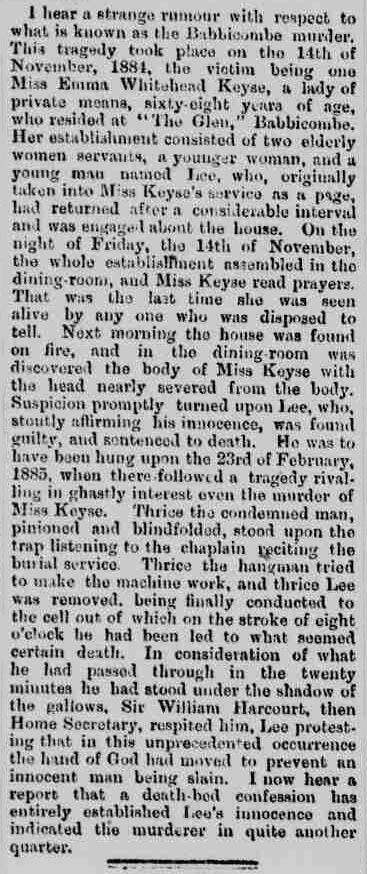
Well into 1889 and beyond rumours surrounding the events at the Glen back in 1884 were rife throughout the British and international media. As with a lot of gossip a substantial amount of this would have to be taken with a pinch of salt for any historian. But without doubt it certainly makes fascinating reading as this article in the Northern Echo – Thursday 21 February 1889 proves without doubt:
“I hear a strange rumour with respect to what is known as the Babbicombe murder. This tragedy took place on the 14th of November 1884, the victim being Miss Emma Whitehead Keyse, a lady of private means, 68 years of age who resided at “the Glen”, Babbicombe.
Her establishment consisted of two elderly women servants, a younger woman, and a young man named Lee, who, originally taken into Miss Keyse’s service as a page, had returned after a considerable interval and was engaged about the house.
On the night of Friday, the 14th of November, the whole establishment assembled in the dining room, and Miss Keyse read prayers. That was the last time she was seen alive by any one who was disposed to tell.
In the house was found on fire, and in the dining room was discovered the body of Miss Keyse with their head nearly severed from the body.
Suspicion promptly turned upon Lee, who, stoutly affirming his innocence, was found guilty, and sentenced to death. He was to have been hung up on the 23rd of February, 1885, when there followed a tragedy rivalling in ghastly interest even the murder of Miss Keyse. Thrice the condemned man, pinioned and blindfolded, stood upon the trap listening to the chaplain reciting the burial service. Thrice the hangman tried to make the machine at work, and thrice Lee was removed, being conducted to the cell out of which on the stroke of eight o’clock he had been led to what seemed certain death.
In consideration of what he had passed through in the 20 minutes he stood under the shadow of the gallows, Sir William Harcourt, then Home Secretary, respited him, Lee protesting that in this unprecedented occurrence the hand of God had moved to prevent an innocent man being slain. I now hear a report that a deathbed confession has entirely established Lee’s innocence and indicated the murderer in quite another quarter.”
